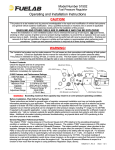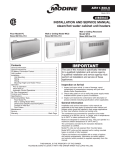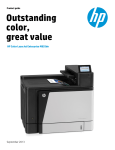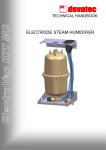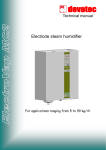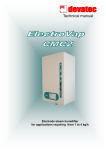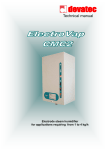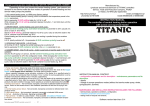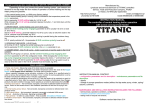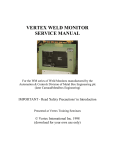Download Product Instructions
Transcript
Model Number 51504
Fuel Pressure Regulator
Operating and Installation Instructions
CAUTION!
This product is to be installed only by persons knowledgeable in the repair and modification of vehicle fuel systems
and general vehicle systems modification. Only a qualified technician or mechanic who is aware of applicable
safety procedures should perform the installation of this product.
GASOLINE AND OTHER FUELS ARE FLAMMABLE AND CAN BE EXPLOSIVE!
Perform the installation in a well ventilated location only to minimize the build up of fuel vapors. NO open flames,
smoking or other sources of ignition are to be present during installation, to prevent fire or explosion that can cause
serious injury or death. Grinding, cutting, and drilling must be performed with care to prevent ignition. Draining and
removal of all fuel and ventilation of vapors in vehicle and fuel system is recommended when performing such
procedures. Proper eye and personal protection is required at all times during installation.
WARNING!
The Vehicle’s fuel system may be under pressure! Do not loosen any fuel connections until relieving all fuel system
pressure. Consult an applicable service manual for instructions to relieve fuel system pressure safely.
This product is intended for racing, off-road, or marine use only. This fuel system component is capable of altering
engine tuning and therefore not legal for sale or use on emission controlled motor vehicles.
Product Contents:
Check the diagram and list of components
Adjustment Screw
(right) to ensure that no components are
missing from box. Contact your Fuelab
Plug
(3X) -906 O-ring
distributor immediately for replacement.
51504 Features and Performance Ratings:
Inlet Port Sizes
-6AN Military Port
Seat Size
Large
Regulation Slope
0.75 PSI/GPM
Maximum Flow
2.5 GPM at 5 PSID
Capacity
(570 LPH at 0.35 Bar)
Pressure
Pressure Range “E”
Adjustment Range
4-12 PSID
(0.28-0.82 Bar)
Jam Nut
Flat Washer
(3X) Bracket Lock Washers
Regulator
Barbed Fitting
Bracket
(3X) Bracket Screws
WARNING! Exceeding maximum flow capacity may result in an over-pressure operating condition.
Before Installation, Plan Entire Fuel System:
These instructions are limited to general topics of regulator component installation and may not include specific
information pertaining to your application. These instructions are written assuming the use of an electric fuel pump
capable of at least 15 PSIG outlet pressure and limited to the specified Maximum Flow Capacity (above). This
regulator has an internal spring that can be changed for other pressure ranges, including “L” range, for 1.5-3.5
PSID, “T” range for 10-25 PSID, if required by the specific application. Higher, fuel injection pressure ranges are
recommended for a different model of regulator (unless for very high flow EFI applications). Visit our company
website for specific details pertaining to example fuel systems and other solution ideas. Additional information
including advanced troubleshooting, any special alerts and FAQ’s pertaining to this and other products is also
available.
General Regulator Performance Notes:
The notation “PSIG” means pressure in Pounds per Square Inch (PSI) relative to the prevailing atmospheric
condition or outside air. This is referred to as Gauge Pressure. The notation “PSID” means pressure in PSI relative
to another pressure source or called the Differential Pressure (relative to Pressure Reference Port in case of
pressure ratings). This regulator acts as a relief valve to control pressure (returning fuel back to fuel cell). Only
“blow-through” boosted applications for carbureted systems should have a line plumbed to the pressure reference
port. The amount of pressure difference to expect with application of full throttle compared to idle (for naturally
aspirated engines) is a function of how much flow the engine is using (reference Regulation Slope, above for
calculations).
105020124-1, No Rev
Page 1 of 4
Plumbing Planning Notes:
Minimize plumbing restrictions between carburetor(s) and regulator for peak performance. Use –6AN (3/8”) to
–10AN (5/8”) line as required per flow rate requirements of the vehicle’s engine and fuel pump. See company website for nitrous oxide use and alternate plumbing schematics. Plumb the return line back to the fuel tank. Use of a
–8AN (1/2”) return line is typically recommended for this model of regulator. See diagram on next page as well as
diagram below, to identify the ports used on the regulator. The two side ports can be interchanged either Outlet or
Inlet, since this valve operates as a relief valve (pressure is relieved from the regulator out to the rest of the fuel
system, by returning unused fuel back to the fuel cell). Plumb the Pressure Reference Port using the barbed fitting
for “blow-through” carbureted applications only (blow-through means that a turbo or supercharger is used to
pressurize the carburetor(s)). When this occurs, fuel pressure must be compensated by the change in float bowl
pressure. If motor is naturally aspirated (Normal carbureted application, with float bowl vented to atmosphere) allow
this port to vent to atmosphere, do not plug or plumb to any pressure source. The fuel line used must handle high
pressure. The use of fuel line such as stainless steel braided line and “AN” style fitting connections is
recommended. The fuel ports (two –6AN Inlet-Outlet Ports and one –6AN Return Port) use “AN” or “military” style
fittings. This plumbing standard is commonly used with racing and high performance applications. See step 6 on
next page for additional information on this port standard. A fuel filter with a 60 micron or lower particle rating is
required to be used upstream of regulator and downstream from fuel pump to protect it and the carburetor from
foreign object damage. Reference the Schematic Diagram below for filter locations. Use of a liquid filled gauge
exposed to engine compartment heat is not recommended as the liquid inside the gauge may exert measurement
errors. DO NOT plumb gauge port to any gauge mounted inside the vehicle or in passenger compartment. A line
burst can spill fuel inside passenger compartment and on occupants, possibly causing serious injury or death. An
electric gauge or pressure transducer system is recommended for readings in a passenger compartment.
Typical Carbureted Fuel System Schematic Diagram:
Follow Fuel Cell Manufacturer's
Recommendations for Proper
Cell Vent Plumbing
Vented Fuel Cell or Fuel Tank.
Tank must be Plumbed According
to Maximum Pump Flow Rate.
Consult Pump Manufacturer's
Specifications and Recommendations.
Use Y-Block or Fuel Log
to Split Flow for
Multiple Float Bowls
51504 Regulator
Fuel Straining Filter Required, Typical
Micron Rating: 100-250, Fuelab
Straining Filter Recommended. Straining
Filter may be Installed in Fuel Pump,
Consult Pump Manufacturer's Specifications.
To Induction
Tube (for BlowThrough Applications
Only!, Otherwise Do
Not Plumb or Plug)
Fuel Gauge Shown
in Gauge Port, Liquid
Filled Gauge may
have Error Due to
Temperature Variations.
Fuel Filter Required, 60 Micron
Stainless Steel Element for
Methanol Use or 10 Micron
Paper Element for Gasoline.
Fuelab Filter is Recommended.
Electric
Fuel Pump
Installation Steps:
1. Disconnect the ground terminal from battery and allow the vehicle’s engine and exhaust system to cool.
Relieve fuel system per applicable service manual. Follow all Warnings and Cautions written on previous page
of these instructions.
2. Modify, remove or replace other fuel system components as required per established build plan (reference
notes on previous page and above).
105020124-1, No Rev
Page 2 of 4
3. Use the supplied bracket as a drilling template to mark holes for mounting bracket. Choose a location that
minimizes exposure to excessive heat, near carburetor(s). Mounting bracket can be modified as required. Use
clear or colored enamel paint to protect bracket surface after any modification.
4. Apply light oil onto the threads of the Adjustment Screw. Small amounts of air leakage in the adjustment
hardware may be present during operation. This is a normal operating condition. Thread the Adjustment
Screw by hand until a slight tension is felt, this position is the minimum pressure setting. Do not tighten screw
any further. Pressure is to be adjusted later in these instructions. Install the Flat Washer, then the Jam Nut.
Tighten the Jam Nut hand tight for later adjustment.
5. Install Bracket to regulator using supplied Bracket Screws and Bracket Lock Washers. Tighten Bracket Screws
between 25-40 in·oz of torque (snug, do not over tighten screws).
6. Install the fuel fittings (not supplied). The threads used on these Fuel Ports are not tapered or pipe threads.
Do not use Teflon® thread tape or thread sealant on these threads, as this can cause leakage or introduce
debris into the fuel system. Fittings to be used with these style of ports require use of the enclosed –906
O-rings for proper sealing (reference diagrams, below). Use light oil to lubricate the O-rings just prior to
installation. Install the O-rings onto the fuel fitting first. Position the O-ring in the thread relief of the fitting as
shown in the diagram, below. Thread fitting into regulator and tighten between 5 and 15 ft·lbs of torque.
7. Use Teflon® tape or thread sealant on all 1/8”-NPT fittings to be used for the Gauge Port and Pressure
Reference Port (see diagrams, below). Install fittings or plug as required. If pressure reference port is not
plumbed to the induction tube (for pressurized carbureted system only) then install the Barbed Fitting (supplied)
and allow fitting to vent to atmosphere (do not plumb or plug port).
8. Install regulator assembly into vehicle, fastening the bracket to the vehicle. Attach fuel lines, Gauge Port line (if
external pressure gauge is used in application) and Pressure Reference Port line (if applicable). Boosted
applications (such as turbo or supercharger) will require a hose clamp on barbed fitting to prevent hose from
coming loose. Use of –3AN or –4AN line can also be used as a substitute to the barbed fitting.
(1/8") Barbed Fitting
(See Note 7, Above)
Install with Cup
toward Regulator
Front
(Logo)
-6AN Inlet-Outlet
Port (on each side)
Adjustment
Screw
1/8"-NPT Pressure
Reference Port
(Pressurized
Carburetor Only)
Jam Nut
Gauge Port Plug
(can be substitued
for gauge fitting)
Flat Washer
Unique Serial
Number
Identification
Example -6AN to
-8AN Reducer
Fitting Shown
(Not Supplied)
-906 O-ring
-906 O-ring Shown
Prior to Fitting
installation
1/8"-NPT Gauge Port
-6AN Return Line Port
-906 O-ring
Example -6AN to
-8AN Reducer
Fitting Shown
(Not Supplied)
Example -6AN to
-8AN Reducer
Fitting Shown
(Not Supplied)
(3X) Bracket Lock Washer
(3X) Bracket Screw
9. Inspect fuel system for any contact of fuel lines or wires with other components that can cause chafing or
rubbing. Secure all components and fuel lines.
10. Connect the vehicle’s battery. Turn on fuel pump (typically by bypassing fuel pump relay) without engine
operating. The pump will have to operate several seconds (30+) to prime and drive air out of the fuel system.
Fuel system pressure should read about 4 to 5 PSIG (use an external gauge for adjustment if a permanent
gauge is not used). If the pressure is higher than desired pressure, re-inspect the return line for restrictions.
Inspect vehicle for any leaks. Turn off fuel system and repair any leaks that may be present before continuing.
11. When adjusting pressure, be sure that fuel pump is operating to monitor pressure. Increase pressure by
rotating adjustment clockwise. Do not thread Adjustment Screw past jam nut within 1/8”. Over tightening the
adjustment screw can damage the regulator.
12. After final adjustment of fuel pressure, tighten Jam Nut. Road test vehicle, and retest pressure upon return to
ensure accurate adjustment.
105020124-1, No Rev
Page 3 of 4
LIMITED WARRANTY
FUELAB, a division of FCP, Inc. , having its principal place of business at 826A Morton Court, Litchfield, IL
62056, USA ("Manufacturer") warrants its FUELAB products (the "Products") as follows:
1. Limited Warranty.
Manufacturer warrants that the Products sold hereunder will be free from defects in material and workmanship for a
period of 2 Years from the date of purchase to the original purchaser. If the Products do not conform to this Limited
Warranty during the warranty period (as herein above specified), Buyer shall notify Manufacturer in writing, or by
phone, of the claimed defects and demonstrate to Manufacturer satisfaction that said defects are covered by this
Limited Warranty. If the defects are properly reported to Manufacturer within the warranty period, and the defects
are of such type and nature as to be covered by this warranty, Manufacturer shall, at its own expense, furnish
replacement Products or, at Manufacturer's option, replacement parts for the defective Products. Removal of
Products from vehicle (Vehicle means any automotive, bike or marine transportation powered by an internal
combustion engine. This product is NOT intended or designed for use on aircraft, experimental or otherwise.),
shipping to Manufacturer and installation of the replacement Products or replacement parts shall be at Buyer's
expense.
2. Other Limits.
THE FOREGOING IS IN LIEU OF ALL OTHER WARRANTIES, EXPRESS OR IMPLIED, INCLUDING BUT NOT
LIMITED TO THE IMPLIED WARRANTIES OF MERCHANTABILITY AND FITNESS FOR A PARTICULAR
PURPOSE. Manufacturer does not warrant against damages or defects arising out of improper or abnormal use or
handling of the Products; against defects or damages arising from improper installation (where installation is by
persons other than Manufacturer), against defects in products or components not manufactured by Manufacturer,
or against damages resulting from such non-Manufacturer made products or components. Manufacturer passes on
to Buyer the warranty it received (if any) from the maker thereof of such non-Manufacturer made products or
components. This warranty also does not apply to Products upon which repairs have been effected or attempted
by persons other than pursuant to written authorization by Manufacturer.
3. Exclusive Obligation.
THIS WARRANTY IS EXCLUSIVE. The sole and exclusive obligation of Manufacturer shall be to repair or replace
the defective Products in the manner and for the period provided above. Manufacturer shall not have any other
obligation with respect to the Products or any part thereof, whether based on contract, tort, strict liability or
otherwise. Under no circumstances, whether based on this Limited Warranty or otherwise, shall Manufacturer be
liable for incidental, special, or consequential damages.
4. Other Statements.
Manufacturer's employees, representatives' and/or resellers ORAL OR OTHER WRITTEN STATEMENTS DO NOT
CONSTITUTE WARRANTIES, shall not be relied upon by Buyer, and are not a part of the contract for sale or this
limited warranty.
5. Entire Obligation.
This Limited Warranty states the entire obligation of Manufacturer with respect to the Products. If any part of this
Limited Warranty is determined to be void or illegal, the remainder shall remain in full force and effect.
6. Warranty Service
What Does This Warranty Not Cover? Any problem that is caused by abuse, misuse, or an act of God (such as a
flood) is not covered. Also, consequential and incidental damages are not recoverable under this warranty. Some
states do not allow the exclusion or limitation of incidental or consequential damages, so the above limitation or
exclusion may not apply to you.
How Do You Get Service? In order to be eligible for service under this warranty you MUST return the Warranty
Registration card, or register on-line at www.fuelab.com/warranty within 30 days of purchasing the Product.
If something goes wrong with your product contact FUELAB at 1-800-541-2345, International customers call 001217-324-3737, for a Return Authorization Number (RMA). After receiving your RMA send it postage paid, fully
insured, with a brief written description of the problem to:
FUELAB Warranty Department, 826A Morton Court, Litchfield, IL 62056
We will inspect your Product and contact you within 72 hours of receipt to give the results of our inspection and an
estimate of the labor and/or parts charges required to fix the Product, if applicable. If covered under this limited
warranty Manufacturer will repair Product and return it to you at no cost. If the Product is NOT covered under this
warranty and if you authorize repairs, we will return the repaired Product to you COD, or prepaid via credit card,
within 72 hours. There is no charge for inspection. If return product is found to be free of defects a $25.00 shipping
and handling charge will be applied. We will return the repaired Product to you COD, or prepaid via credit card,
within 72 hours.
105020124-1, No Rev
Page 4 of 4




